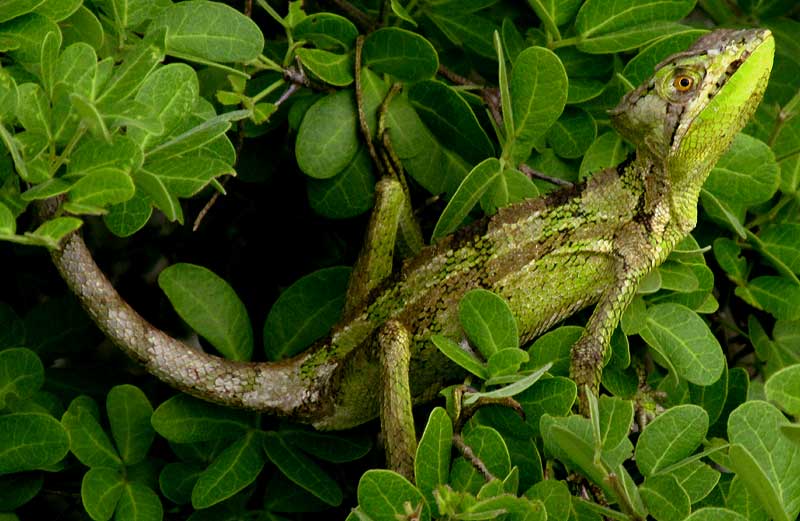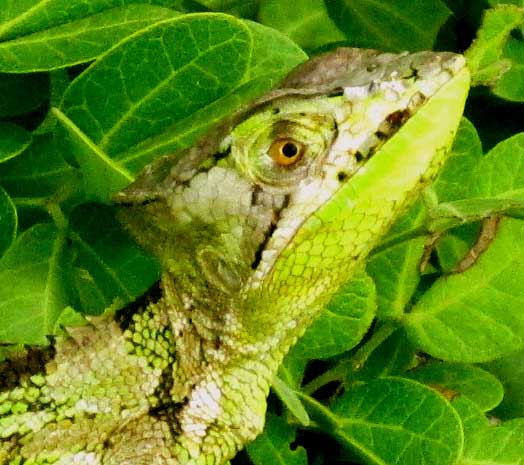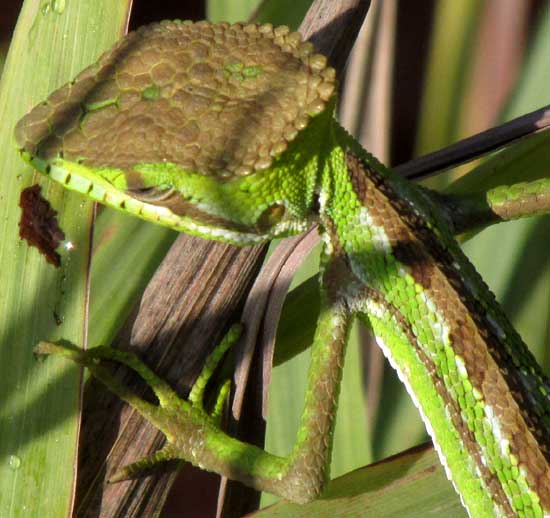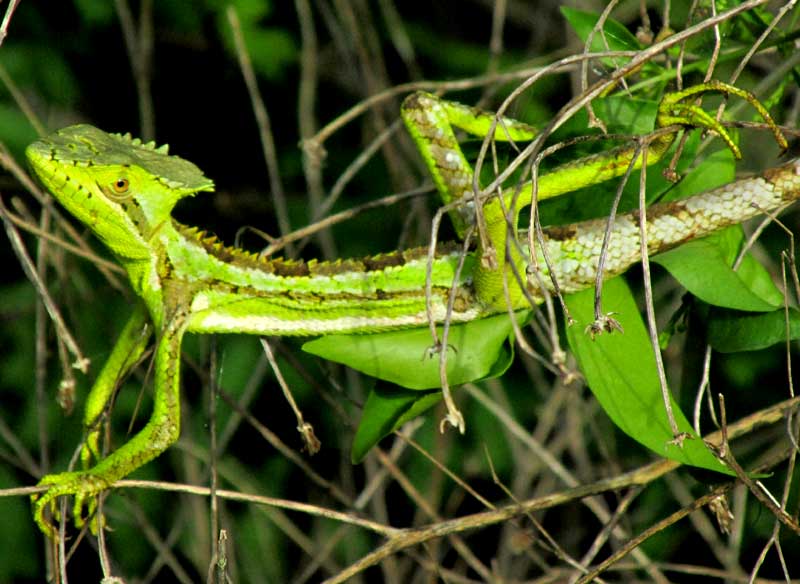Excerpts from Jim Conrad's
Naturalist Newsletter

from the July 12, 2015 Newsletter issued from Río Lagartos, on the north-central coast of Yucatán, MÉXICO
SERRATED CASQUEHEADED BASILISK
Out at the mangroves' edge, about chest high in a Blackbead tree, something new turned up, shown above. A closer look at the interesting bulge at the back of this lizard's head is provided below:

The helmet-like projection at the head's back told me that this was a basilisk, a kind of lizard famous for being such a fast, light runner that it can run across the surface of water. Down at Chichén Itzá basilisks were common around my hut, and I've seen them up here, too. You might enjoy browsing our page with several nice photos and stories about the Striped Basilisk, Basiliscus vittatus, the species of basilisk most common there, at www.backyardnature.net/mexnat/basilisk.htm.
But this basilisk is different. First, though we've documented several color variations of the Striped Basilisk, and noted how its "helmet" varies with age and sex, I'd never seen a greenish Striped Basilisk, plus a Striped Basilisk's helmet is like a vertical fin at the back of the head, not the kind of porch-like affair we see jutting from the back of the head on this one.
So this was a new basilisk species for me, which means that it was a member of the Casqueheaded Basilisk Family, the Corytophanidae, along with the the commonly seen Striped Basilisk, but this one belonged to a different genus. We had LAEMANCTUS SERRATUS, known as the Serrated Casqueheaded Basilisk, a species endemic to this part of the world, occurring in widely separated island populations mostly in Mexico. The IUCN Red List map shows the largest population in the Yucatan Peninsula, another along the southwestern Gulf Coast mostly in Veracruz state, another population in the Central Depression of Mexico's Chiapas state, and tiny groupings here and there elsewhere in southern Mexico, plus some reports from northern Belize and Honduras.
Often such fragmented populations develop as a consequence of the population having once been much larger, but now is in retreat, leaving isolated groupings behind. Still, at least in the Yucatan, the species appears to be stable and fairly common. Serrated Casqueheaded Basilisks also are propagated through the pet trade, the species being especially popular in Europe.
Our individual perched on his bed of Blackbead leaves may be greener than usually observed because the species can change color between green and brown in a matter of minutes.
Serrated Casqueheaded Basilisks specialize in tropical dry forests. In the Yucatan, they're most abundant in the driest part, the peninsula's far northwestern corner. Like Striped Basilisks, they can run on their back legs. And I can report that as I was slowly repositioning to get a better view of the helmet, after remaining very still for a good while, it streaked into the Blackbead's branches so fast that my mind hardly registered the departure.
It eats insects, snails, small lizards and frogs.
from the May 14, 2017 Newsletter issued from Rancho Regenesis in the woods ±4kms west of Ek Balam Ruins; elevation ~40m (~130 ft), N20.876°, W88.170°; north-central Yucatán, MÉXICO
BASILISK ON THE LEMON GRASS
Above, I was able to photograph the lizard's head only from the side. One morning this week as I watered the garden, another individual turned up placidly sunning himself atop a big clump of Lemon Grass, and this time I got a good view of the "casque head" from above, emphasizing just what a curious growth it is, as you can see below:

We have two common species of basilisks here. The most frequently seen is the Striped Basilisk, with a fin-like appendage running lengthwise at the head's back, unlike the Casqueheaded's crosswise one. The Striped Basilisk's page is at www.backyardnature.net/mexnat/basilisk.htm
issued June 11, 2020 from Tepakán, Yucatán, MÉXICO
BASKING BASILISK
In early morning the individual shown below was making good use of his long legs and toes to secure himself atop a tangle of dead weeds along a woodland trail, in early morning sunlight:
